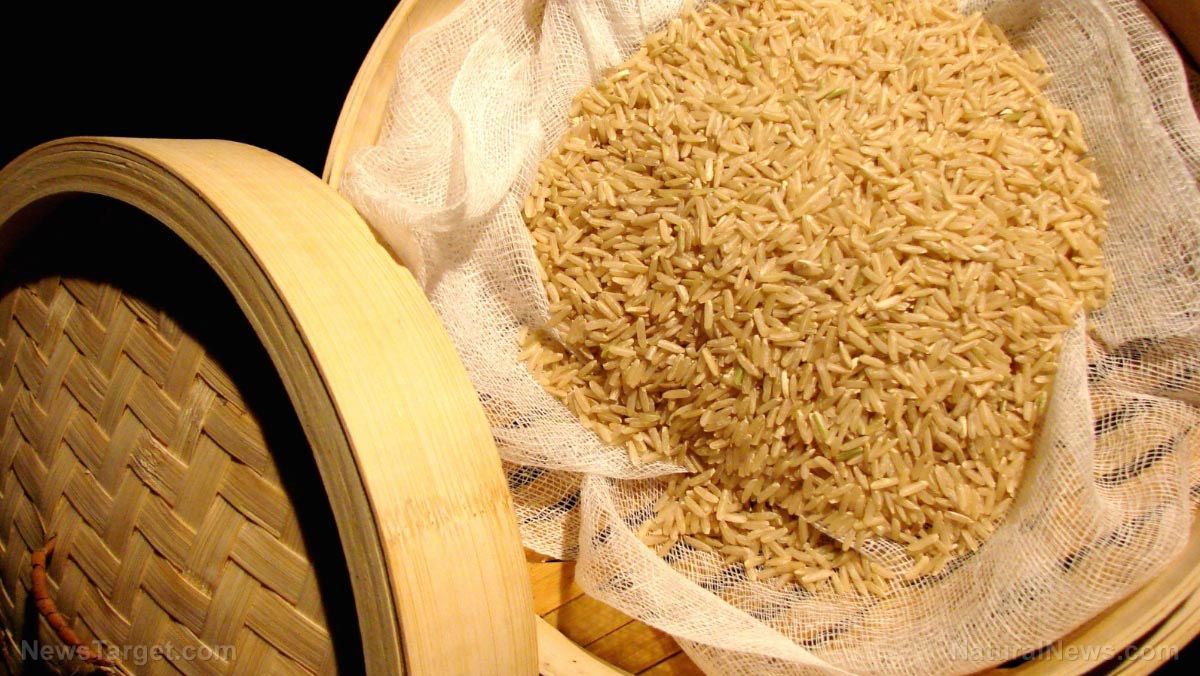
Now, it is recognized as one of the world's most nutritious rice varieties, according to a study published in the American-Eurasian Journal of Agronomy.
Organic brown rice is a whole grain, a nutritious, high-fiber food associated with healthy eating. It comes in several varieties, including long-, medium- and short-grain. Aside from being an excellent source of carbohydrates and energy, organic brown rice is low in fat, salt and sugar and contains no cholesterol, gluten, additives or preservatives.
Once its outer, inedible hull is removed, brown rice contains three parts of the grain kernel:
- The bran. This is the outer layer of the grain kernel that contains fiber, antioxidants, B-vitamins, phytochemicals and the majority of the minerals.
- The germ. This is the nutrient-rich core or inner portion at one end of the grain that contains fats, B-vitamins, phytochemicals and antioxidants like vitamin E.
- The endosperm. This is the starchy middle and largest layer that contains protein, carbs and small amounts of B-vitamins and minerals.
According to a study published in the journal Antioxidants (Basel), brown rice has several bran layers full of valuable vitamins, minerals and phytochemicals. Among these are thiamin (B1), niacin (B3), pantothenic acid (B5), pyridoxine (B6), folate (B9), vitamin E (tocopherol and tocotrienols), vitamin K, choline, calcium, copper, iron, magnesium, manganese, phosphorus, potassium, selenium and zinc.
The phytochemicals found in brown rice include functional lipids, phytosterols, phenolic acids, flavonoids, anthocyanins, proanthocyanins, tocopherols, tocotrienols, gamma-aminobutyric acid (GABA) and y-oryzanol.
The unpolished whole grain brown rice has more nutrients than white rice. After milling, white rice is polished to appear more palatable than brown rice. According to a study published in the International Journal of Multidisciplinary Research and Development, 15 percent of protein, 85 percent of mono and polyunsaturated fat, 90 percent of calcium, 75 percent of phosphorus, 80 percent of thiamin, 70 percent of riboflavin and 68 percent of niacin are removed during polishing.
An unbalanced diet based on unenriched white rice leaves many people vulnerable to neurological diseases due to vitamin B1 deficiency.
Health benefits of organic brown rice
According to studies, organic brown rice can do the following:
Support healthy immune function
A study published in the Journal of Nutritional Science and Vitaminology, found that brown rice is an excellent source of nutrients that are critical for the growth and function of immune cells, including iron, manganese, protein, selenium, zinc and essential amino acids.
Another study, this one published in the journal Food Chemistry, highlighted the phytochemical profiles of eight brown rice varieties, including their powerful phenolic acid content and antioxidant activity that promote the body's natural immune defenses.
Support musculoskeletal health
A study that appeared in the journal Foods, reported brown rice as an excellent source of protein, containing 37 percent of the total protein as essential amino acids and 18 percent as branched-chain-amino acids (BCAA) – including leucine, isoleucine and valine that support the body's muscle repair and building processes.
Brown rice supports healthy bones as it is rich in magnesium, which helps provide the bones their physical structure. Magnesium-rich brown rice prevents bone demineralization and is beneficial for medical conditions like arthritis and osteoporosis.
Support healthy cognitive function
In a study published in the journal Methods and Protocols, it was found that brown rice helped maintain a higher level of cognitive function among healthy elderly people better than white rice. Researchers believe this is likely due to the high amounts of vitamin E, which protects and preserves brain function and prevents neurodegeneration. This is in addition to B-vitamins pyridoxine (B6) and folic acid (B9), copper, magnesium, manganese and other essential nutrients in brown rice that support healthy brain function and development.
A study that appeared in the journal Neuromolecular Medicine reported on the neuroprotective effects of germinated brown rice from oxidative stress, attributing to the abundance of gamma-aminobutyric acid, which is beneficial for those at risk of neurodegenerative diseases.
Sprouted brown rice contains healthful components, which support the inhibition of a harmful enzyme called prolyl-endopeptidase that is associated with cerebral-related disorders, such as senile dementia and amnesia. (Related: Eat more brown rice for a healthier brain.)
Support healthy cardiovascular function
Brown rice contains heart-healthy nutrients, such as potassium, selenium and dietary fiber. As a low-glycemic food that contains gamma-aminobutyric acid (GABA) and plant sterols, brown rice can also help you maintain healthy blood sugar and cholesterol levels that are already within the normal range. (Related: Brown rice is a nutrient-dense food that can lower cholesterol levels and prevent the formation of blood clots.)
According to a study that appeared in the Asian Journal of Food and Agro-Industry, brown rice is an excellent source of selenium — an essential component of various enzymes and proteins called selenoproteins that are also involved in reproduction and the metabolism of thyroid hormones, which affect every cell and all the organs in your body by regulating the rate at which your body uses calories or energy.
Support healthy digestive function
Brown rice contains nutrients that support the growth and activity of healthy gut bacteria. According to a study published in the Journal of Obesity and Chronic Diseases, brown rice eaters are healthy and have good bowel movements, which suggests a good intestinal environment and good composition of microbiota. Naturally abundant in dietary fiber, brown rice also brings relief from other troubling conditions, such as colitis.
Brown rice is also rich in manganese, which promotes optimal nutrient absorption and supports the healthy production of digestive enzymes that are already within the normal range. One cup of cooked brown rice has 5.2 mg niacin (vitamin B3), which is involved in keeping your digestive system in working order, in addition to converting food into energy.
Support healthy nervous function
A cup of brown rice will provide you with 88 percent of the daily value of manganese, a trace mineral that helps produce energy from protein and carbohydrates and is involved in the synthesis of fatty acids – which are both important for a healthy nervous system.
Manganese is also an important element of the antioxidant enzyme found in all living cells called superoxide dismutase (SOD), which scavenges the superoxide anion and helps break down potentially harmful oxygen molecules in cells, thus preventing peroxynitrite production and free radical damage.
Support healthy energy levels
As a great source of complex carbohydrates, brown rice can provide you with more lasting energy than foods that contain simple carbs. It is a great source of slow-release energy to sustain optimal body function throughout the day. Because of its high fiber content and complex carbohydrates, brown rice digests slower in the body for sustained energy.
A study published in the American Journal of Clinical Nutrition also revealed that brown rice contains high levels of fiber, protein, manganese, thiamin and other nutrients that support your body's natural energy production.
Support dental health
A study published in the Journal of Dental Research found that people who ate two or more servings of brown rice each week had stronger teeth than those who did not. The researchers believed that this was because brown rice contains high amounts of calcium, which acts as a remineralization agent for tooth enamel; phosphorus, which naturally protects and rebuilds tooth enamel; magnesium and potassium, which help the body absorb calcium; and vitamin K, which prevents tooth decay.
Support healthy skin, hair and scalp
Brown rice is packed with powerful antioxidants such as flavonoids, phenolic acids, tocotrienols, tocopherols, anthocyanins, proanthocyanins and ferulic acid that help protect your skin from oxidative stress, support its healthy functions and minimize the risk of premature aging. It is rich in proteins that work as a powerful exfoliant and it has fiber, vitamins and essential minerals that promote cell growth and stimulate blood flow in the skin, giving it a vibrant and bright appearance.
The fiber and starch in brown rice support healthy, shiny hair. Packed with selenium, brown rice can help address dandruff issues.
Support sensible weight management goals
A study published in the American Journal of Clinical Nutrition found that women who consume most of their dietary fiber from whole grains like brown rice were 49 percent less likely to gain weight compared to those who eat refined-grain food like white rice.
Adding high-fiber brown rice to your diet may help reduce cravings by curbing your appetite. This makes brown rice an ideal tool for achieving sensible weight management goals, especially when accompanied by a healthy diet and regular exercise. The manganese in brown rice also promotes optimal metabolism.
Watch the video below to learn why you should switch to organic brown rice.
This video is from the Health Ranger Store channel at Brighteon.com.
More related stories:
Food for thought: Brown rice reduces cognitive dysfunction linked to Alzheimer's
Brown rice protein powder - Increase muscle mass and stabilize weight
Brown rice and other whole grains can prevent type 2 diabetes
Sources include:
Please contact us for more information.























